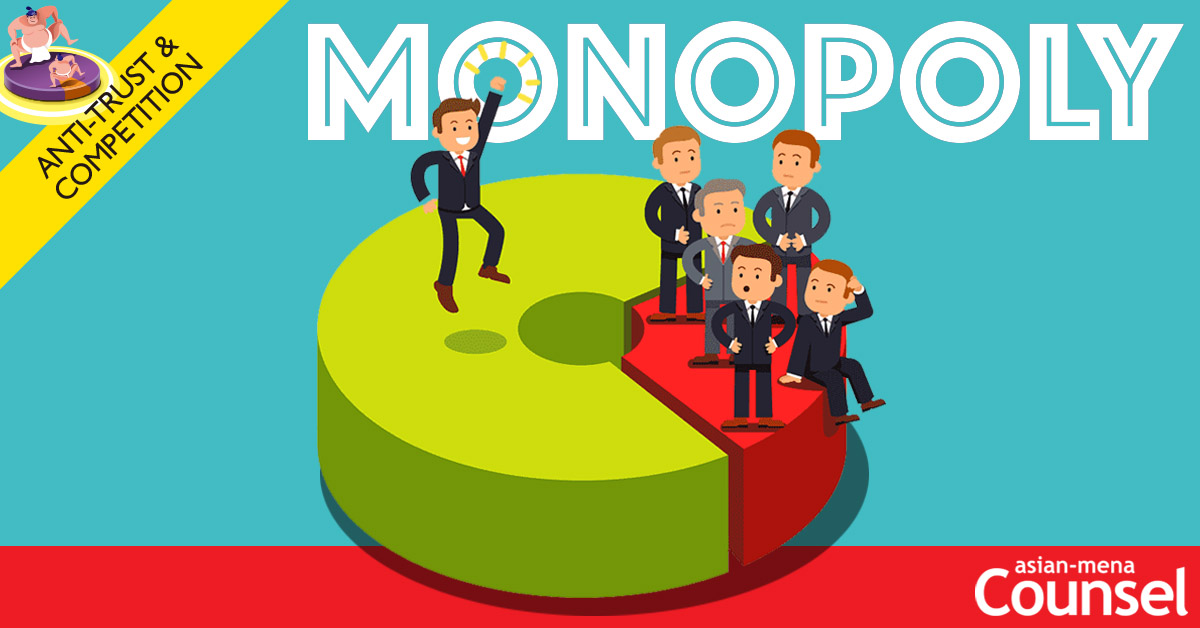Published in Asian-mena Counsel: Anti-Trust & Competition Special Report 2020

By Michael Gu and Grace Wu of AnJie Law Firm
E: michaelgu@anjielaw.com
E: wuguici@anjielaw.com
China’s competition authority has acquired the competence and courage to investigate some of the most complicated and new types of monopoly behaviours.
 INTRODUCTION
INTRODUCTION
The year 2019 marked the 11th anniversary of the implementation of the PRC Anti-monopoly Law, which was also the first full calendar year for the State Administration for Market Regulation (SAMR) to take over the role as China’s single central level antitrust enforcement agency.
After integration, the SAMR was relatively active in its antitrust enforcement practice. In 2019, the SAMR published 19 penalty decisions on alleged monopoly agreements and abuse of market dominance. The types of industries investigated by antitrust law enforcement authorities in 2019 were diverse, while the key industries of the investigations were still in the areas closely related to people’s daily life, for example, gas and water supply, building materials, automobiles and pharmaceutical industries. Some 13 out of 19 cases published by the SAMR were related to the people’s daily life.
LEGISLATION
On January 2, 2020 the SAMR released a revised draft of the Anti-monopoly Law for public comment (the Revised Draft)1. Although the Revised Draft follows the current Anti-monopoly Law’s basic framework, it significantly enhances the legal liability of Anti-monopoly Law violators. It also clarifies practical issues such as ‘controlling rights’, improves merger control review procedures and introduces a new type of monopoly behaviour and methodology for identifying dominance in the internet sector. Currently, there is no clear timetable for the finalisation of the Revised Draft and promulgation of the new Anti-monopoly law. Nevertheless, the Revised Draft signals the SAMR’s enforcement priorities and indicates the legislative trends that could have a profound impact on China’s antitrust enforcement landscape.
Also, the SAMR published three sets of interim provisions to implement the Anti-monopoly Law and unify both substantive and procedural regulations previously published by the National Development and Reform Commission (NDRC) and the State Administration for Industry and Commerce (SAIC). On June 26, 2019, the SAMR promulgated the Interim Provisions on Prohibition of Monopoly Agreements2, the Interim Provisions on Prohibition of the Abuse of Market Dominance3, and the Interim Provisions on Curbing Abuse of Administrative Power to Exclude or Restrict Competition4 (collectively as ‘The Three Interim Provisions’). The Three Interim Provisions set out detailed behavioural monopoly models and assessment standards of various monopoly behaviours. The Three Interim Provisions also elaborate procedural requirements in the case investigation process.
While the Anti-monopoly Law is under revision, the SAMR released the Anti-monopoly Compliance Guidelines for Undertakings for public comments on November 28, 20195. It was the first time that antitrust compliance guidelines have been issued at the state level.
CARTELS
The SAMR and local agencies published nine cartel cases in 2019. Compared with that of 2018 (14 cases), the number of cartel cases dropped slightly in 2019. The total amount of the penalties was Rmb20.97 million, and the average amount of fines imposed in each case by the SAMR was relatively low compared with that of previous years. This may be because the penalised companies were small or medium-sized enterprises and their turnover was low. The most significant case was the Chongqing Sintered Brick Manufacturer cartel case6 where the enterprises argued for the exemption under Article 15 of the AML, but the enforcement authority rejected their arguments.
Chongqing Sintered Brick Manufacturer cartel case
On August 9, 2019, Chongqing Administration for Market Regulation (Chongqing AMR) published a decision fining six Chongqing sintered brick manufacturers and three individuals a total of Rmb1,938,501 and confiscating unlawful gains of a total of Rmb1,931,291 for entering into a horizontal monopoly agreement.
The involved companies and individuals engaged in the following activities during the period from March 2014 to July 2018:
- coordination of the production schedule of the participating members, and provision of compensation to members who ease to produce the sintered brick products;
- establishment of a joint operation office;
- price fixing of sintered brick products; and
- allocation of sales of sintered brick products and distribution the profits among participating members.
Chongqing AMR identified two types of monopolistic behaviours in this case:
- fixing the lowest prices of sintered brick products; and
- restricting the product quantity though the way of reducing member’s production.
The involved companies and individuals argued in the hearing held by Chongqing AMR that the suspension of production of some members was a response to implement the government’s ‘off-peak production’ and ‘environmental protection’ policies, which shall be regarded as an exception under Article 15 of the Anti-monopoly Law. However, Chongqing AMR rejected this argument on the grounds that there were no objective factors such as economic downturns during the implementation of the monopoly, nor could it achieve the purpose of environmental protection. Therefore, Chongqing AMR concluded that the monopoly agreement reached by the involved companies and individuals shall not be entitled to exemption in accordance with Article 15 of the Anti-monopoly Law.
VERTICAL RESTRICTION
The antitrust agencies concluded and published four cases in relation to vertical restriction cases, and all of them related to resale price maintenance (RPM). However, among these cases, the Hydron Contact Lens RPM case7 was terminated and the Lenovo RPM case8 was suspended without any penalties. They were the first and the second vertical monopoly that were suspended or terminated. In these cases, although the parties had carried out the monopoly behaviour, they acknowledged their misconduct and provided remedial measures during the investigation. This shows that even in vertical restriction cases, as long as the parties can actively offer the remedial measures that can eliminate the adverse effects on competition, they may be exempted from penalty.
As in the past, antitrust law enforcement authorities have kept an eye on the automobile industry, in which vertical restrains are often conducted. Due to the large sales of car companies, the fine imposed on them is always large even if the penalty calculation was based on regional sales of these companies. In 2019, the SAMR published two penalty decisions against two big automobile manufacturers (Toyota RPM9 and Ford RPM10 cases).
Toyota RPM and Ford RPM
On December 27, 2019, the SAMR published the penalty decision against Toyota Motor (China) Investment. The former Jiangsu Price Bureau launched its investigation in December 2017, and the penalty decision was concluded by Jiangsu Administration for Market Regulation (the Jiangsu AMR) on November 20, 2019. Toyota fixed local distributors’ prices displayed on internet portals and set minimum resale prices for multiple Lexus models.
Toyota instructed its distributors in Jiangsu to offer same price quote for online inquiry and set minimum resale price for offline sales of certain Lexus passenger cars. Toyota also specified discount policies and related monitoring and punishment measures. The distributors implemented the resale price stipulated by Toyota. Jiangsu AMR, therefore, concluded that Toyota reached and implemented an illegal vertical agreement.
Similarly, Changan Ford Motor was also penalised for engaging in the RPM monopoly by the SAMR according to a press release published on June 5, 2019 on the SAMR’s website; however, the penalty decision has not yet been published. Since 2013, Ford has restricted the distributors’ resale price by formulating a ‘price list’, reaching a ‘price self-discipline agreement’, and setting the lowest prices during the auto show and the lowest online prices in Chonqing.
It is worth noting that Toyota was fined for Rmb87.6 million, representing 2 percent of its sales in 2016 in Jiangsu Province. The fine was not based on the total sales of Toyota in China; rather it was based on the regional sales. The penalty imposed on Ford is also based on the regional sales in Chongqing (ie, Rmb162.8 million, representing 4 percent of Ford’s previous year sales in Chongqing). Article 46 of the Anti-monopoly Law does not specify whether the fine should be based on the total sales or the regional sales or sales of related products, so it is at the discretion of the enforcement agencies. Even the Revised Draft does not provide any clarification in this regard.
ABUSE OF DOMINANCE
In 2019, the SAMR and local agencies concluded six abuse of dominance cases. Among these cases, two cases were terminated without any penalties due to the timely rectification of the investigated parties.
Eastman case11
On April 16, 2019, the Shanghai Administration for Market Regulation (the Shanghai AMR) issued a penalty of Rmb24.38 million on Eastman (China) Investment Management for its abuse of dominance. The Shanghai AMR states that Eastman abused its dominant position in the alcohol ester-12 coalescing agent market in mainland China, and unreasonably conducted exclusive dealing, thereby eliminating and restricting market competition.
To identify the dominant position of Eastman, the Shanghai AMR mainly considered Eastman’s market share in the relevant market, financial and technological conditions, competition constraints from competitors and customers’ reliance on the product and entrance barrier. Based on the above assessment, the Shanghai AMR held that Eastman had a dominant position in the alcohol ester-12 market in China.
According to the penalty decision, Eastman conducted the following wrongdoings:
- Eastman and its six direct distributors agreed on the minimum purchase quantity for each contract year in the next two to three years.
- Eastman required its direct clients and distributors in the Chinese mainland market to sign a long-term take-or-pay clause in the relevant agreement. Under the take-or-pay clause, direct clients and distributors shall fulfil the minimum purchase requirement even if the minimum purchase quantity exceeds their actual demand.
- Eastman signed and implemented exclusive agreements involving most-favoured-nation (MFN) clauses. The MFN clauses in this case refer to the global best price and regional sales discount given to the customer whose purchase reaches the agreed global summation ratio and agreed regional quantity. Unlike the typical MFN clause in the context of EU and US jurisdictions, which refers to the company with dominant position requiring the counterparty to offer the most preferential terms, the above-mentioned clause in this case is actually a type conditional rebate.
According to the Shanghai AMR, the combination of minimum purchase quantity term, take-or-pay clause and MFN clause enabled Eastman to conduct exclusive dealing, which imposed the lock-in effect on the market competition. Therefore, Eastman was fined amounting to 5 percent of its respective revenue in 2016. In this case, the SAMR establishes a precedent for the identification of exclusive dealing, and it also challenges the legality of new type of restrictive behaviours such as the MFN clause (even it is not a typical MFN in the US and EU jurisdictions) and royalty rebates.
COMMENT
After 11 years of Anti-monopoly Law implementation, China’s antitrust enforcement agency has accumulated a wealth of experience, and China has become one of the most important antitrust jurisdictions in the world.
In terms of cartels, the number of cartel cases decreased slightly and the total amount of penalties was relatively low compared with previous year. However, in early 2019, the SAMR started an investigation on German carmakers including Daimler, Volkswagen and BMW with regard to their possible collusion in emission controls following the European Commission’s probe in September 2018. This shows that Chinese antitrust law enforcement agencies have been closely monitoring the cases investigated by other jurisdictions and may follow suit from time to time.
In terms of vertical restriction, RPM has been the focus of law enforcement agencies for years, especially in certain industries such as automobile and pharmaceutical. We expect that RPM will continue to be a focus of law enforcement agencies in the future, and companies should remain vigilant.
The SAMR has been more confident and professional when handling abusive cases. The detailed analysis illustrated in the Eastman case indicates the competition authority’s competence and courage to investigate some of the most complicated and new types of monopoly behaviours.
Furthermore, in 2020, we expect more antitrust enforcement guidelines and regulations will be promulgated that will promote antimonopoly law enforcement and promote the establishment and development of a relatively mature and transparent anti-monopoly legal framework.
______________________________
1. The original Chinese version is available at the SAMR’s website:
www.samr.gov.cn/hd/zjdc/202001/ t20200102_310120.html.
2. The original Chinese version is available at the SAMR’s website:
https://gkml.samr.gov.cn/nsjg/fldj/201907/ t20190725_305165.html.
3. The original Chinese version is available at the SAMR’s website:
https://gkml.samr.gov.cn/nsjg/fldj/201907/ t20190725_305166.html.
4. The original Chinese version is available at the SAMR’s website:
https://gkml.samr.gov.cn/nsjg/fldj/201907/ t20190725_305167.html.
5. The original Chinese version is available at the SAMR’s website:
www.samr.gov.cn/hd/zjdc/201911/ t20191128_308890.html.
6. The original Chinese penalty decision is available at the SAMR’s website:
www.samr.gov.cn/fldj/tzgg/ xzcf/201908/t20190821_306163.html.
7. The original Chinese terminal decision is available at the SAMR’s website:
www.samr.gov.cn/fldj/tzgg/ xzcf/201905/t20190521_293971.html.
8. The original Chinese suspension decision is available at the SAMR’s website:
www.samr.gov.cn/fldj/tzgg/ xzcf/201911/t20191115_308573.html.
9. The original Chinese penalty decisions are available at the SAMR’s website:
https://www.samr.gov.cn/fldj/tzgg/xzcf/201912/t20191227_309552.html
10. The press release is available at the SAMR’s website:
https://www.samr.gov.cn/xw/zj/201906/t20190605_302109.html
11. The original Chinese penalty decisions are available at the SAMR’s website:
https://www.samr.gov.cn/fldj/tzgg/xzcf/201904/t20190429_293241.html
______________________________

E: michaelgu@anjielaw.com
E: wuguici@anjielaw.com
![]() Click Here to read the full issue of Asian-mena Counsel: Anti-Trust & Competition Special Report 2020.
Click Here to read the full issue of Asian-mena Counsel: Anti-Trust & Competition Special Report 2020.


